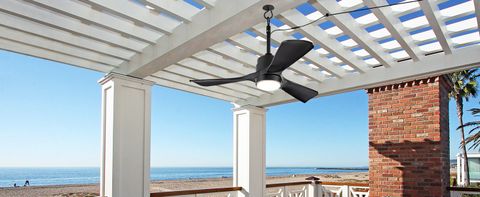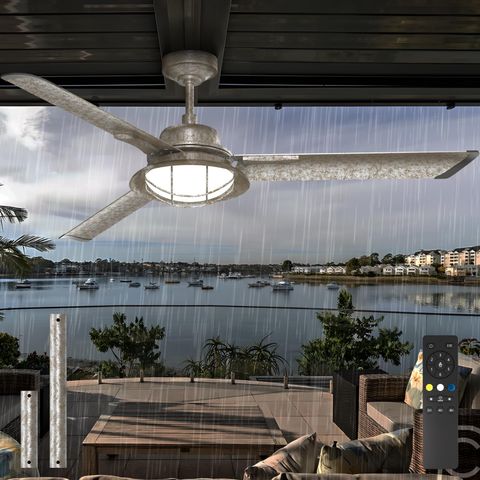Picture this: You’re sitting on your balcony, trying to enjoy a peaceful evening, but the heat is relentless. The air feels thick and stagnant, and your usual breeze isn’t cutting it anymore. This is where the right outdoor ceiling fan becomes your best friend. But with so many options on the market, how do you know which one will actually work for your space? It’s not just about size or style – it’s about understanding the ratings that matter most.
Outdoor ceiling fans aren’t just about aesthetics anymore. They’ve become essential pieces of furniture for balcony dwellers who want to extend their living spaces beyond the confines of their indoor rooms. Whether you’re entertaining guests, relaxing with a book, or simply enjoying the view, a quality outdoor fan can transform your balcony from a stuffy space into a comfortable retreat. However, choosing the right one requires understanding more than just how it looks. You need to know how to read the ratings that tell you whether a fan will actually perform well in outdoor conditions. These ratings cover everything from weather resistance to energy efficiency, and they’re crucial for making the smart investment in your outdoor comfort.
The Basics of Outdoor Fan Ratings
Think of outdoor fan ratings like a nutritional label for food – they tell you what you’re getting and how well it will perform. The main categories include IP ratings, wind resistance, and material durability. Let’s break them down simply.
IP ratings are your first line of defense against the elements. The higher the number, the better protection. For balconies, you’ll want to look for at least IP44, which protects against solid objects larger than 1mm and water splashes. Some fans go up to IP65, offering even better protection against dust and water jets. This means your fan won’t rust or break down after a light rain shower.
Wind resistance ratings are equally important. A fan rated for 20 mph wind speed might handle a gentle breeze, but if you live in a windy area, you’ll want something rated for 30 mph or more. Consider the typical weather in your area and plan accordingly. If you’re in a place with frequent storms, you might even want to consider fans rated for 40 mph or higher.
Material quality affects everything from performance to longevity. Aluminum and stainless steel are generally preferred for outdoor use because they resist corrosion better than plastic or regular metal. The blades themselves matter too – look for materials that won’t warp, fade, or crack in direct sunlight.
Understanding Weather Protection Ratings
When it comes to protecting your investment, weather protection ratings are non-negotiable. These numbers might seem technical, but they’re actually quite straightforward once you understand what they mean.
The IP rating system works like this: the first number shows protection against solid objects, while the second number indicates protection against liquids. An IP44 rating means your fan can handle dust particles up to 1mm and water splashes from any direction. That’s great for most balcony situations, but it’s not enough if you’re in a very humid climate.
For those who experience heavy rains or live near the ocean, IP65 or higher ratings are worth considering. These fans can withstand powerful water jets and offer complete protection against dust ingress. The extra cost often pays off in terms of longevity and peace of mind.
Don’t overlook the importance of UV resistance either. Sun exposure can cause fading and cracking over time, especially in cheaper materials. Look for fans that specifically mention UV protection or have been tested for sun resistance. This is particularly important if your balcony gets direct afternoon sun for several hours each day.
Choosing the Right Size for Your Balcony Space
Size matters when it comes to outdoor fans, and this isn’t just about how big they look. The actual blade span determines how much air they can move effectively. Here’s where things get tricky – you want enough airflow without overwhelming the space.
A general rule of thumb is to measure your balcony’s square footage. For spaces under 150 square feet, a 36-inch diameter fan is usually sufficient. If you have more space, say 150-250 square feet, then a 42-inch fan makes more sense. Anything over 250 square feet might need a 52-inch fan.
But here’s the thing – it’s not just about square footage. Consider the height of your ceiling too. If you have a high ceiling, you might need a fan with a longer downrod to ensure the blades are positioned correctly for optimal airflow. A fan that’s too close to the ground can create dangerous turbulence, while one that’s too high might not move enough air.
Also think about the shape of your balcony. Round or irregularly shaped spaces might benefit from smaller fans positioned strategically rather than one large fan. Sometimes, two smaller fans can provide better coverage than one oversized unit.
Energy Efficiency and Operating Costs
This is where most people get excited – energy efficiency ratings can save you money over time. You might pay more upfront for a high-efficiency model, but the savings on electricity bills can add up quickly.
Look for fans with ENERGY STAR certification. These models typically use 50% less energy than standard fans while providing the same amount of airflow. That translates to significant savings, especially if you run your fan regularly during hot summer months.
The motor type also matters. DC motors are generally more efficient than AC motors, though they might cost more initially. They also offer better speed control and can adjust airflow based on temperature changes. Some fans even come with smart controls that automatically adjust based on room conditions.
Consider the wattage too. A typical outdoor fan uses between 50 and 150 watts, depending on size and features. If you’re planning to use it frequently, choose a lower wattage option to keep operating costs down. Remember, you can always increase the speed later if you need more airflow, but you can’t reduce the power consumption once you’ve chosen a higher-wattage model.
Installation Considerations and Mounting Options
Installing an outdoor fan properly is half the battle. Without proper mounting, even the best-rated fan can become a safety hazard or fail prematurely. Start by checking your balcony’s structural capacity before purchasing.
Most balcony installations require a ceiling mount designed specifically for outdoor use. These mounts must be able to support the weight of the fan plus any additional loads from wind or vibration. Check that your mounting hardware is rated for outdoor conditions and that it includes all necessary components.
If you’re unsure about installation, don’t hesitate to hire a professional. This is one situation where paying a little extra upfront can prevent costly repairs or replacement later. Many manufacturers offer installation services, or you can find local contractors who specialize in outdoor fan installations.
Consider the location carefully. Make sure the fan won’t interfere with any existing fixtures or create safety hazards. Also, think about access for maintenance – you’ll need to clean the blades and check connections periodically. Ensure there’s adequate clearance around the fan for easy access.
Maintenance and Longevity Tips
A quality outdoor fan is an investment that deserves care and attention. Proper maintenance can extend its life by years, saving you the cost of replacement. Regular cleaning is probably the most important routine task.
Dust and debris can accumulate on blades and motor components, reducing efficiency and potentially causing overheating. Clean your fan at least twice a year, or more frequently if you’re in a dusty environment. Use a soft cloth and mild soap solution, and always disconnect power before cleaning.
Check for loose screws or connections monthly. Wind and temperature changes can cause fasteners to loosen over time. Tighten any that feel loose, but don’t overtighten, which could damage the mounting hardware.
Lubricate moving parts according to manufacturer instructions. Most modern fans require minimal lubrication, but some older models might benefit from periodic oiling. Follow the recommended schedule to prevent wear and tear.
Keep an eye out for signs of wear such as unusual noises, wobbling, or reduced airflow. These issues often indicate problems that need attention before they become major failures. Addressing small problems early can prevent bigger, more expensive repairs down the road.
Choosing the right outdoor ceiling fan for your balcony apartment is more than just picking something that looks good. It’s about understanding what the ratings really mean and how they apply to your specific situation. From weather protection and sizing to energy efficiency and maintenance, every factor plays a role in creating a comfortable outdoor space that lasts.
Remember, the most expensive fan isn’t always the best choice – sometimes a mid-range model with the right ratings and features will serve you better than a premium fan with poor specifications. Take your time to research, compare ratings, and consider your actual needs rather than just going with the latest trend.
Your balcony should be a place of relaxation and enjoyment, not discomfort or frustration. With the right outdoor fan, you can make that dream a reality. Whether you’re hosting dinner parties or simply enjoying a quiet moment alone, a properly selected fan will provide the perfect balance of comfort and style. Invest wisely, maintain consistently, and your balcony will remain a welcoming retreat for years to come.














